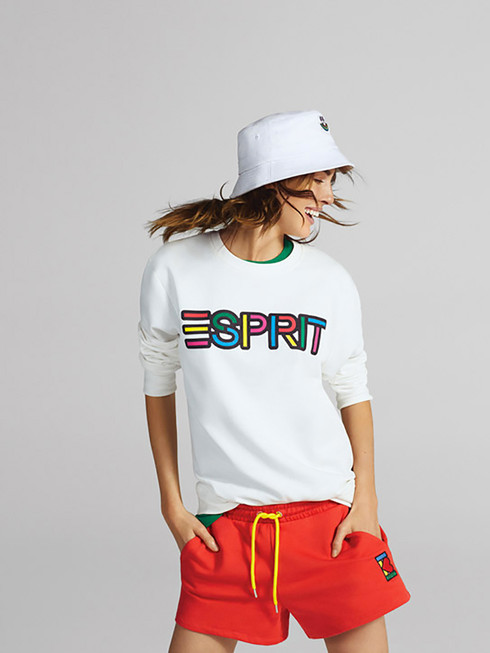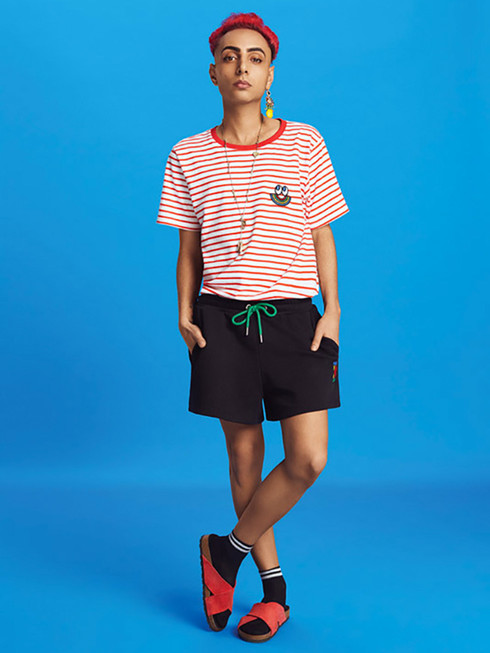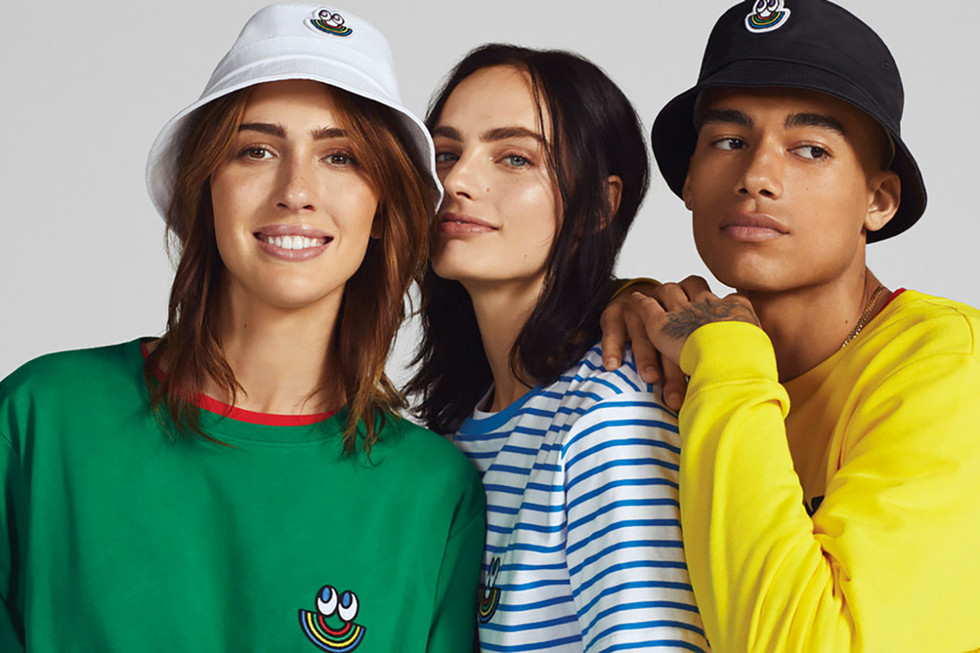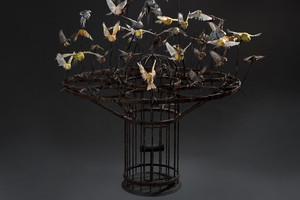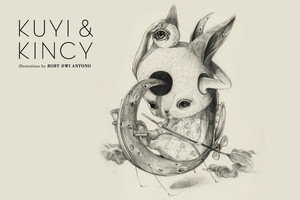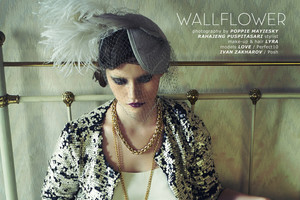Esprit + Craig&Karl: An Interview with Teddy Quinlivan
Written by Meghan Scottintro and interview by Meghan Scott, conducted and transcribed by Lisa Bouville
A limited edition collection, Esprit + Craig&Karl, between renowned design duo Craig & Karl and iconic brand Esprit launched on May 31st, 2019. The message: love, equality and unity. 50 years ago, the Stonewall riots catapulted the global Pride movement of the LGBTQ+ community. A protest for equal rights and sexual preference and gender quality emerged into a brilliant universal parade to celebrate diversity, freedom and equality.
This collection celebrates the beauty of a colourful and diverse world. Each piece can be mixed and matched based on individual style. “The artists Craig Redman and Karl Maier create colorful art that is often filled with simple messages executed in a thoughtful and humorous way. For their collaboration with Esprit and in celebration of Pride, they decided to play with one of Esprit’s most recognisable design elements: the stripes.”
Having grown up with my great grandfather (grandmother’s father on my mother's side) being a force in the LGBQT+ community in Toronto dating back to the ’20s, eachPride Season I am reminded of the struggle and the fight the community has to endure. And I am grateful for the support and acceptance my great grandfather had within his community, albeit small during that time. Without this support, my family I know and love would basically not exist. Growing up as a teenager in the 90’s in a Toronto suburb where bro mentality flourished, I could never understand how people could be so unaccepting and close-minded, and it was hard to navigate during my awkward teenage years. Finally, with my best friend, I found the rave community in Toronto which finally opened up a whole new world of people. They accepted our differences, and even though I am/was a straight woman, I was a total tomboy. We got to immerse ourselves into a culture of understanding and support. There are still too many communities globally who still don’t accept diversity, and collaborations like this help expand acceptance and support the LGBTQ+ community.
I had the chance to ask Teddy Quinlivan some questions, she was the key model for the Esprit + Craig&Karl campaign. Quinlivan was discovered in 2015 by Nicolas Ghesquière and instantly became a runway favourite, walking shows such as Jeremy Scott, Caroline Herrera, Marc Jacobs and Jason Wu, to name a few. In 2017 she decided to come out as transgender amid the scrutiny of the Trump administration that was proposing bills and legislation that would set the LGBTQ+ community back decades. It’s still happening and in order to make the world a better place we have to support our fellow humans, celebrate our differences and stop get offended or worrying over how people are identifying themselves as and who has what in their pants.
Lisa Bouville: What was your first reaction after being approached for the Esprit + Craig&Karl?
Teddy Quinlivan: It was just exciting for me because I knew that the brand Esprit is just such a well-recognized brand throughout Europe, and it has a powerful seen in the United States as well. It’s kind of funny because my mom has all these old Esprit sweatshirts from the ’80s, so I kind of always knew what it was. Esprit has a great brand name, so anytime a brand with that much recognition approaches me, I found out to be very special, and I especially when I knew it was the Pride collection. They didn’t just contact me because I am a model, they approach me because I had a message and this particular collection was about Pride, being yourself, acceptance of all different types of people, all different kinds of genders and sexualities, racism, backgrounds. In that sense, it was super special to be approached.
LB: This collaboration and the involvement with the Ali Forney Centre will bring more light to the LGBTQ+ youth and their struggles, have you been involved in similar projects previously?
TQ: This is the first project that I have ever done with Esprit, but I’ve been an activist since I came out in the fall of 2017. I tried to line myself with as many reputable organizations as possible, and I’m still learning about more because there is so much work that has to be done, Ali Forney Center is jus such an incredible place where they are housing trans and LGBTQ+ youth in New York City. I think, whenever I can do my job in a way that also benefits my community and in the world as an all that it just the most rewarding thing. I always tried to work alongside organizations; for example, two weeks ago I was in Cannes for the film festival, and I did some charity work for amfAR, which is an organization that works on aids research, which is a disease that directly affects the LGBTQ+ community. I try to keep it. There are so many issues I can be passionate about, and I am passionate about climate change and other things, but I feel like where my voice is the strongest and fits in the bath is LGBTQ+ work.
LB: Have you noticed the shift in fashion regarding unisex and androgen style becoming more mainstream, how do you feel about the impact it will have on the mainstream? Do you think the trend can change the stigmatization ignorant people may have of the LGBTQ+ community?
TQ: To answer the second part of your question first, I think that fashion place has a super important role and determining what we find beautiful, what we find acceptable, what we find aspirational. Fashion detects what we find aspirational because it is this very high brow thing. It is also an industry of images and sector of marketing. So the images that you see when you’re scrolling through your phone on Instagram, or the images that you see when you’re flipping through a magazine, or the images that you see at the bus stop while you’re waiting, those are powerful images that inform you what is cool, what is beautiful, what is fashionable. I think the power that fashion has is reliable in terms of the way society sees beauty as an all. We’ve got a few periods where fashion is very minimal, very opulent, and then it’s very masculine, and then it’s very feminine. It is just a reflection of the moment because fashion is a form of art, and I think that art is a reflection of the time, a reflection of culture as an all. Because of the LGBTQ+ acceptance movement that’s going on, and because of this third wave of feminism that’s happening right now, and all these things, I think there is this shift to gender non conforming dressing. What was conventional thirty years ago for a woman to wear, what was considered acceptable and fashionable is just so different now. I would never expect to see women in sweatpants on the runway or women wearing baggy clothes or jeans on the runway, perhaps if I was living in the ’80s, but now it’s just so conventional, and comfort is a part of our culture. Women want to be comfortable, women want to look comfortable, women want to feel beautiful while being comfortable, and I think that has been the most significant shift. It is not necessarily unisex. Unisex do an extent, but I think it is more a society of comfort. I think that was always something that granted to man. Men could always wear pants, men could always be comfortable, men could always wear t-shirts. There is such a freedom to express yourself through fashion now. I can wear a glittery, sparkly chain male Swarovski crystal dress, or I could wear cowboy boots, a short and a sweatshirt. I think that the blending of genders is very representative of fashion now. I don’t know if it will stay like that forever, but I think it is of the moment. The social movement of our generation heavily influences it.
LB: What other cultural facets have you seen help shift the ignorance of the mainstream positively (concerning the LGBQT+ community)?
TD: I’ll never forget the first kind of like a gay TV show I ever saw which was Glee. When I was growing up, there was nothing like LGBTQ+ related on television, in my mom’s era it would have been Will and Grace, and it was just a gay man on television. To be honest, I hate like musicals and like singing and all stuff like that, and it was never something up I was really into it. But I still remembered the impact of Glee, the idea that young teenagers in high school were gay and lesbian, and they were falling in love, and they were singing. There was about their struggles in their lives and a kind of reality and understanding of society. Then, one thing led to another and because I felt like that TV show broke the glass selling in terms of what was acceptable to portray on television concerning LGBTQ+ people, and it’s just becoming more and more, and now you’re seeing transgender people, transgender characters in movies and TV. That’s something like, even in the days of Glee, you would’ve never expected it. It’s been a quite rapid societal shift, and I think it’s been extremely positive because transgender people have always existed, it is not like we just appeared like that, we’ve always been there, but maybe we didn’t have the resource. We didn’t have the resources to transition a hundred years ago, just like gay people didn’t have the societal structure to feel safe being out and proud, but now we do, and that’s just the most beautiful thing. Society comes to accept this thing as part of humanity and part of life, particularly in western culture. I think it starts in the west and it expands everywhere else, and I feel pretty soon we will see a lot of more conservative cultures and countries following the direction, which typically what happens in terms of social movements. At times, it is the social movement of LGBTQ+ acceptance under threat, yes, but like we’ve pushed the bar so far that I think now as a society we all agree that there is nothing wrong with being gay. You know, twenty years ago, that would have been a very controversial statement, but now it’s not. The world is coming to terms with the idea that gay people are here, that gay people have always been there and they are here to stay. That try to see the same thing with trans people, started with the gay movement and now it’s a trans movement.
LB: When you think about the future, maybe in 30 years, how do you think people will feel about this era looking back (socially, environmentally, financially, …)?
TD: It’s hard to say. I feel like we made so much progress, and then Donald Trump happened. Not to bring politics too much in this conversation but, I think it does have a lot to do with the fact that the world changed very rapidly. Most people were very willing to accept that change, the idea that now gay people are going to have some rights or black people are going to be treated equally and all these things. But there is a lot of people who are stuck in the past, and they feel that the change happened too quickly, they feel like their lives are threatened by other people’s freedom which I think it is such an unfortunate ideology and way of thinking. Those people, who are stuck in the past, don’t want change or are afraid of change. They latch on to something, like Donald Trump, who promised them empty change, like we’re going to go back to the way things were, like things move to fast. A lot of people latch on that ideology because unfortunately, Donald Trump has a lot of success in shifting attitudes in the world. The leader of the United States is such a prominent social figure, and the United States always set the bar to what was acceptable, what was admirable, what was the next step for western culture. Now the United States isn’t necessarily the leader anymore. I think that’s more conservatively leadership being elected into office in places like Brazil, in places like Italy, so it does have this change effect. I am hoping that people will learn from their mistakes and see how horrible this presidency has been. We will get a new leader who is more inclusive and does care about making the world a better place and would change things. Looking back in history, we’re really in the middle of the movement right now. It’s going to be difficult, and it’s going to be challenging. I can’t even say; I don’t know how people look back on it because I don’t know what will happen tomorrow. What is happening is so unexpected, I don’t if the Trump administration is going to take away rights from some people. It’s too hard to say, but people will look back on it, and think a lot of things, that’s for sure. We have a lot to say about it.
LB: Did the political climate in the United States persuade your decision to go public with gender identity?
TD: Absolutely. For me, when Donald Trump administration started taking away protection for transgender students, and something that happens recently was transgender individuals rebound from serving in the military. I just started to watch my government. This government, that stood for freedom and liberty, dehumanized and delegitimized our humanity. I felt I had to do something, and I had to say something. It was extremely important for me to educate people, so they didn’t feel that way and also latched on the reality that we are all bleeding the same blood, we are all cut in the same clothes, and we are all humans regardless of our gender sexuality, our race, our background, our nationality. So I felt a really strong responsibility to protect my community and to come out to use my voice to be a guiding force.

